
The Bootleg Beatles' Andre Barreau on being George
THE BEATLES IN THE USA: Since first putting on the mop top wigs in 1979, the Bootleg Beatles have played to thousands all over the world, supported Oasis at Knebworth and Rod Stewart at Wembley Stadium, and established themselves as the best Beatles tribute band out there.
And with good reason – the Bootlegs’ stage show recreates every key Beatles era from top to toe, with unnerving musical accuracy and an incredible attention to detail.
We caught up with Andre Barreau, the Bootleg Beatles’ very own George Harrison and a successful musician in his own right (he played guitar on the Robbie Williams smash Angels no less), to find out how he recreates the sounds and style of the quiet Beatle…
What sort of gear do you use for the sounds of The Beatles’ formative years, and how are you recreating George’s early tones?
There’s two things really. There’s obviously the guitars he was playing on the first two albums, before the 12-string Rickenbacker. That’s going to be a Gretsch sound, which is either the Duo Jet on the first LP, which is solid body, or the Country Gent which he went to a little bit after. That’s in combination with an AC30, and in combination with how The Beatles created their own dynamic within the group. How you hit it is a big part of that early Beatles sound, because it’s very much four of them playing at the same time.
Do you play with a combination of picks and fingers?
I think that using heavier strings and a heavier plectrum – not a rock solid thing, but a heavier plectrum – really helps to make licks jump out. Like in She Loves You for example, there’s a couple of key licks that jump out.
In the recording that’s partly due to compression, but it’s also playing back behind the vocal and then having enough volume in the guitar to launch out with it without having to press a pedal necessarily – he wouldn’t have had a pedal.
So heavier strings – I don’t actually use flat wound strings because I just find them too dead. Some people choose to do that, which is what The Beatles would have used, I don’t but I definitely do use heavier strings in that earlier period. I think if you’re playing with light strings, though it’s easy to make the bends, you just don’t get the sound I think.
Click through our gallery for more...
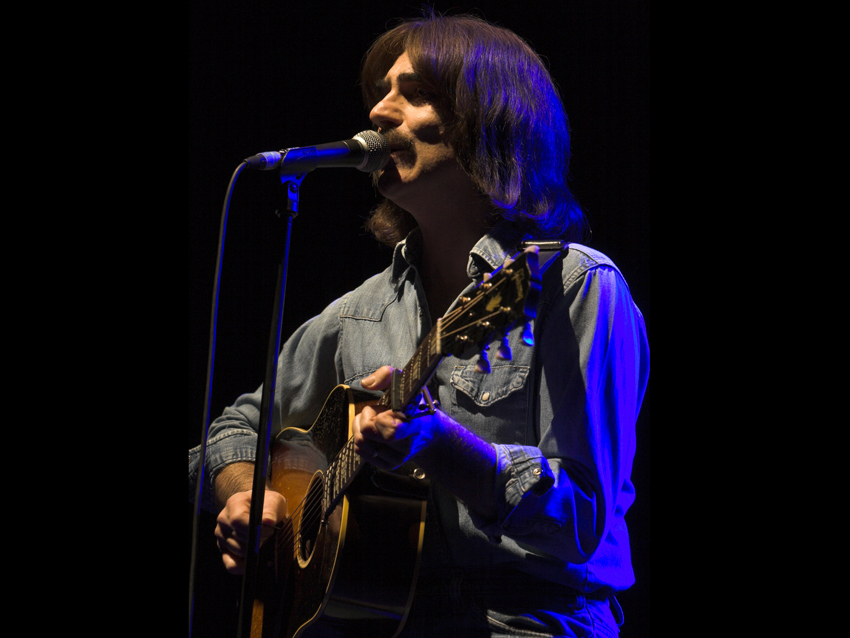
Tone tinkering, effects and She Loves You
It’s quite noticeable that in early Beatles footage, George is often playing about with volume and tone controls.
That’s right, you can see that particularly on the Ed Sullivan Show, which is a great way to look at how George is playing. He’s constantly adjusting his tone, flicking between pickups, moving the volume just a little bit all the time. He didn’t have a solo boost, so he would have to do it partially with his hands and partially with the volume of the guitar.
So is that how you do it too?
I do, although it depends on the kind of venue. The Beatles were initially a club group, so they played like a club group, which is a group playing in a very tight confine. Things really do change when you start playing theatres.
I can’t imagine what it must have been like for The Beatles to play somewhere like the Liverpool Empire, where they’ve just got that small combo that they’re using to hearing with the fans right in from of them and walls all around them. Suddenly they’re in this cavernous – no pun intended! – venue, so that must have had a big effect on how they played.
But for TV and recording, they would have just played like a club group I would have thought.
You’ve been doing it a long time now; do you still go back to the videos and live footage to keep yourself fresh?
Absolutely, it’s kind of a labour of love. In fact, the group’s changed line-up in the last two years. Adam Hastings is the new John and he’s really good at getting sounds.
Our maxim now is that we really only go for the records. The band has been going for so long that we’ve done live versions of things and we’ve done combinations, but now we really try to, particularly in the last ten years, Pas are so much better and they’re so much more accurate that we can really replicate the recordings.
So say on something like I Saw Her Standing There from the first album, we will definitely do what’s on the record. So I’ll play very minimally during the verses, and just let my riffs leap out a bit more when it hits the V chord or the solo.
One big thing that we’ve started using recently is the Boss ME-25 multi effects pedal, that’s been a boon. Take the solo from All My Loving, which is the sub-country and western solo that George plays. That’s got a very smooth sound to it, and playing an AC30 that can be a bit toppy, so by having some EQ settings within the ME-25, when it comes to that solo I can click it on to a much more mellow sound but have a slight volume boost. So I can play that quite lightly. Sometimes in a live situation you can dig in too much and you get away from the sound of the record, which is quite subtly played on that solo. It’s an amazing solo, he just picks some lovely little harmonies and 6th chords in that.
Do you have any other favourite songs or solos from that early period?
Well, I’ve mentioned She Loves You. I think what he plays in between the vocal is incredible. Imagine, you’re 20 years old, you’re in Abbey Road and you’re presented with this song which was fairly fresh when they recorded it, so they hadn’t been recording it for hours and hours, and you’ve got to make your mark by putting your stamp in the small space that you’ve got. He does a brilliant job, the few licks he does are just stand out and historic. So I would say She Loves You is a great example of George doing the maximum with the minimum amount of space.
And I think the riff in Twit And Shout is fantastic. Sometimes he plays a fifth on the G chord at the intro, but then when he’s playing the riff while he’s singing he plays slightly differently. It’s really subtle. That’s on the Duo Jet which is a solid body, and that does sound better with a solid body guitar that with a Gretsch Country Gent, it’s a bit more twangy. There’s so much great guitar work, but they are really fantastic inventions by him I think.
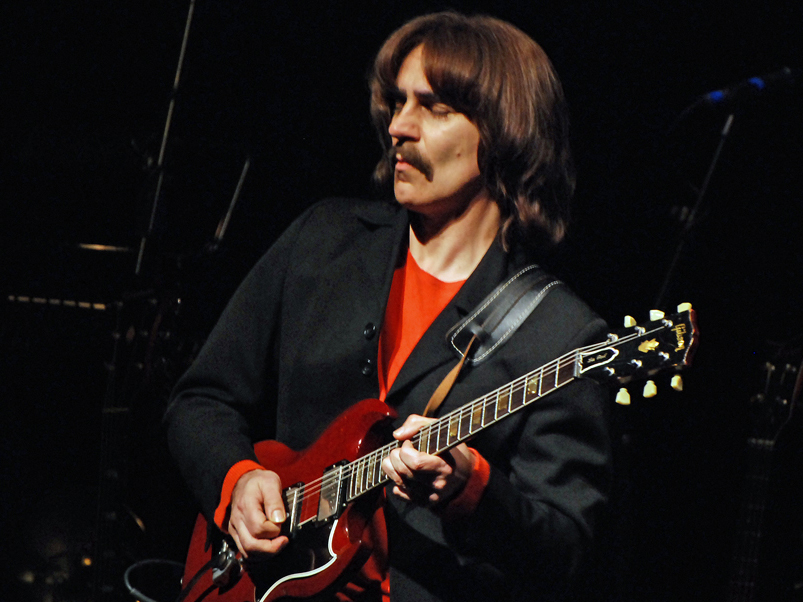
Solos, singing and SGs
Let’s move on the mid-period – how do things change in your set up when you get to those songs?
In the mid-period, obviously you’re just getting towards the end of the 12-string Rickenbacker which is just a brilliant guitar. He had the second one, the prototype which didn’t have an R on it, it sort of had that trapeze tailpiece on it which I actually prefer the look of.
His one must have been amazing. There’s a program called Around The Beatles where he plays live the whole repertoire that they’re doing, and he plays Roll Over Beethoven on a 12-string Rickenbacker. Now I’ve played quite a few, that is really hard because those strings are so tight. It sounds so effortless, so that guitar must have been brilliantly set up.
And then, going on from the 12-string Rickenbacker he used a Gretsch Tennessean in ‘65. I’ve got one of those, which I use for Shea Stadium/Help type period, and that’s brilliant for country licks which of course he maximised on Beatles For Sale.
If you look at a song like Baby’s In Black, he’s not got a lot of space to make himself felt through that, and he does is so beautifully. Brilliantly picked, and the solo is really just so inventive. In that period they’re the guitars that he’s mainly using. And then he gets on to the SG of course.
And he starts bringing in volume pedals and things like.
He uses volume pedals on about four or five songs, Ticket To Ride, I Need You, Yes It Is, and in fact he said that he couldn’t get the co-ordination. So on some of those, I read that John Lennon is doing the foot bit while he’s doing the fingering.
And then of course the SG, which is on Revolver, the kind of signature sound is Paperback Writer, although they’re all playing electric guitar on that. I think that guitar sounds great. It’s my favourite guitar of his to play.
I really love the SG, I think it’s got such an amazing sound and when it’s driven, it just has that She Said She Said sound, there’s no other guitar that can play that riff. I’ve never known how far he continued using the SG, but it was definitely his favourite in ’66.
In the live show, are you swapping guitars but keeping the same amps all the way through?
Yep, amps we keep the same. We don’t go on to Fenders. I used to have varying pedals and stuff, and now we have this multi-fx it’s really great for refining the sound and changing EQ. So I can get more of a Fender sound for later on, when they’re using Fender Twin Reverbs.
They’re very different types of distortion or overdrive on various things, say on Sergeant Pepper, so it’s great to be able to get that subtly out of one unit.
At this stage of The Beatles career George was writing and singing lead more. How does that affect you in the show?
I always get three or four solo songs a night, and obviously one’s doing harmony constantly with George. He was singing an awful lot, and he sings a lot more than people give him credit for in the backing vocals. I can pretty much reach anything that George sang, so apart from the Indian instrumentals which we don’t do, we do pretty much anything buy George.
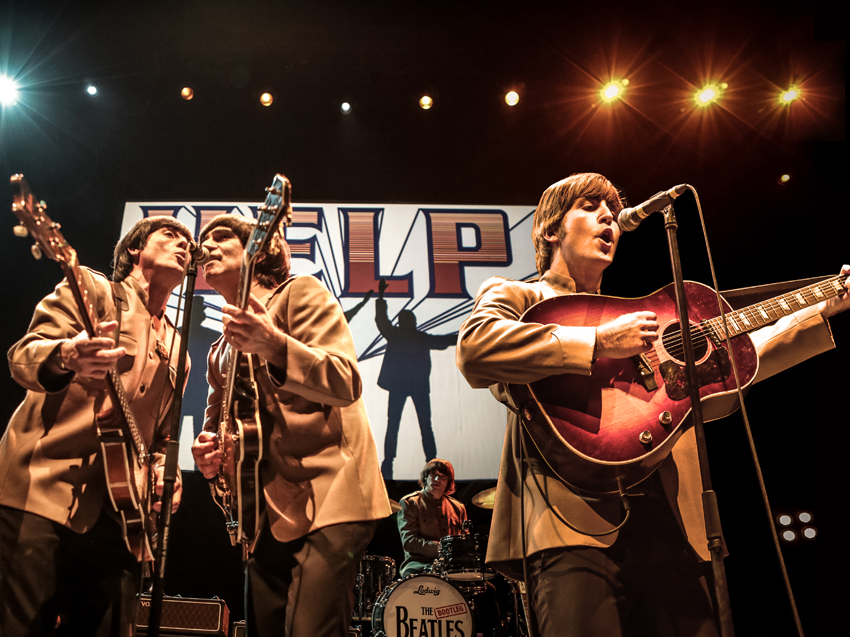
Harmonies and heavy Teles
How tricky is it to work out George's harmonies? He’s always singing a third harmony that floats between Lennon and McCartney that can be really difficult to pin down.
It’s pretty tricky because they’re pretty subtle. In Please Please Me, he’s singing the low harmony while John’s doing that high falsetto that kind of cuts across two parts while Paul stays in the high register. But as the chord goes from E major to A major to B7, when he gets to the A Major he stays in the low note on the A, so it becomes a 7th of the B chord.
And he’s doing a lot of things like that, and they are quite hard to pick out. Your tendency is to go with the whole block of the chord, not to stay with a flat seventh or something. Some are more difficult that others. I think that on Yes It Is, the harmonies are incredible. They swap over the vocals, John goes underneath in the end and George and Paul go over him, and it’s just fantastic but it’s quite a difficult harmony to reproduce live.
That’s on of my favourites, I just think it’s absolutely stunning.
Again, some of it sticks on one note which isn’t that easy – it’s not as easy as it sounds – and then it jumps over John. There were so many people good at harmony in that set up, including George Martin. He was an expert at vocal arranger, as well as their ears being fantastic.
Do you play the SG all the way through Sergeant Pepper era songs as well?
I use it on Sergeant Pepper. I do have a Rocky, the Stat that George painted with his wife’s nail polish, but I tend not to use it. I stick with the SG, as I feel I can get more consistent sounds from that. And then I play the Telecaster. I’ve got a Japanese copy of the Rosewood Telecaster, it’s about 20 years old. It’s got quite valuable actually.
Apparently they’re very heavy?
They weight a ton and they don’t sustain very much. I’ve mucked about with the pickups and tried to get more sustain out of it. It’s alright if you’re playing stuff like Get Back or Don’t Let Me Down, but if you’re trying to do the solo on Come Together, it’s very tight on the high strings so it’s not ideal. I tend to pick up the SG maybe for that, so I can do it a more fluid fashion.
It looks good though!
It looks fantastic, and of course it’s so reminiscent of Let It Be. In fact it’s interesting with George Harrison. I think one thing to say about his generosity is that he gave away both the SG, he gave that to Badfinger, and the Telecaster, he gave that to Delaney and Bonnie. They both ended up being sold down the years, but he gave those wonderful guitars away. I think that says a lot about George, that he didn’t hoard all those guitars, he passed them on.
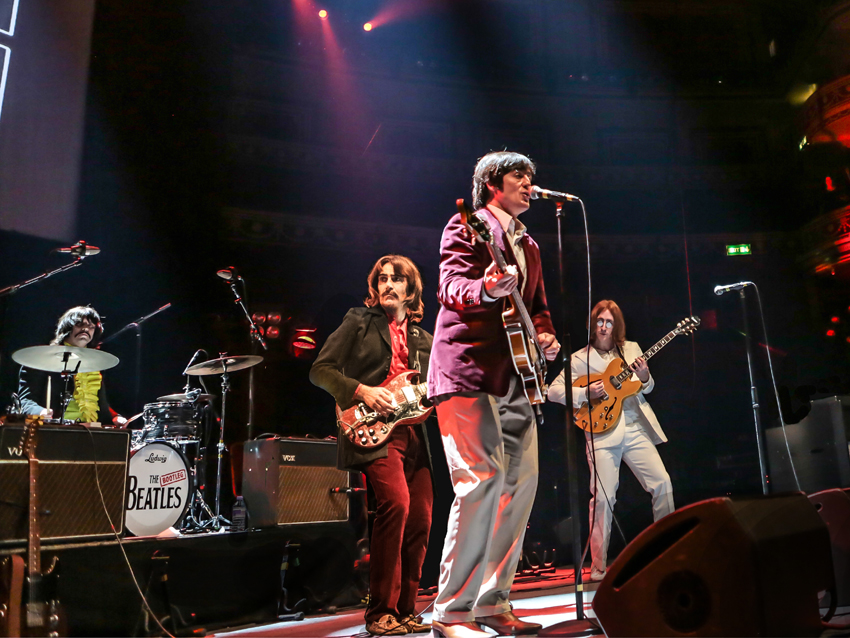
Getting the details right
In the later years he used a really distinctive Leslie sound, how do you replicate that?
That’s actually on the multi-FX pedal, it has a rotary sound on it and it’s perfect. I can be doing, say, the Abbey Road medley and we can be going from a standard slightly warm and distorted sound, and I can click on the rotary and get that beautiful sound before heading back into a heavier sound. I also use it on the solo on Let It Be or if we do The Lond And Winding Road, so it’s a brilliant asset.
Early on in the Bootleg Beatles, the first fifteen years or so, I just used an overdrive pedal with various setting on that and the amp. We just didn’t get into too many effects pedals early on just so that there wasn’t this great big chain and board out there. It didn’t feel right to do The Beatles like that. But now it’s really helped with the sound. But I want to underline that fundamentally it's down to the guitar that you’re playing and the way that you hit it.
In terms of performance, it’s particularly impressive how you inhabit George, from his stance to the way he sings, and his stage presence. How do you balance all that?
If you compared it to doing your own music in your own clothes it’s almost impossible. There’s nothing better than just standing there, being you, and not worrying about anything else other than your music and getting it across to the audience.
We’re trying to worry about the music, and get across the audience. You used the word balance, well half the time I’m on one leg or one heel or something! You want to change your character as George changes physically. He’s very open and smiley early on and becomes more introverted as you go through. Then you’ve got the vocals, and a costume or wig change coming up as well. That’s another thing that’s on your mind!
So it is quite a task really. If we’re playing abroad, it may be a great auditorium but maybe with not the greatest facilities out back, then that’s hard – trying to stick a moustache on in half-light! All these things make it a more difficult job. But all of us think that the mimic is such an important part. Wearing the right costumes is important, but it’s how you inhabit that costume and make it move that makes it believable to the audience. You know all these things that George has done because you’re a Beatle fan, and if you see something somebody does you see it. They’re very important.
It’s all about the detail.
We always say that the more detail you put in, it adds up to a big picture. And so every move you can add, whether it’s how George would approach the microphone differently at Shea Stadium to what he would have done on the Ed Sullivan shows, that all helps. Particularly with YouTube, which is a whole other ballgame for mimicking now.
When The Bootleg Beatles first started, there was just nothing available, apart from A Hard Day’s Night on at Christmas – you couldn’t even get a video of it. So you had to watch it, take it in and hopefully try and replicate it. But now even the most obscure TV performance is available on YouTube and it’s a brilliant asset for us, doing what we do.
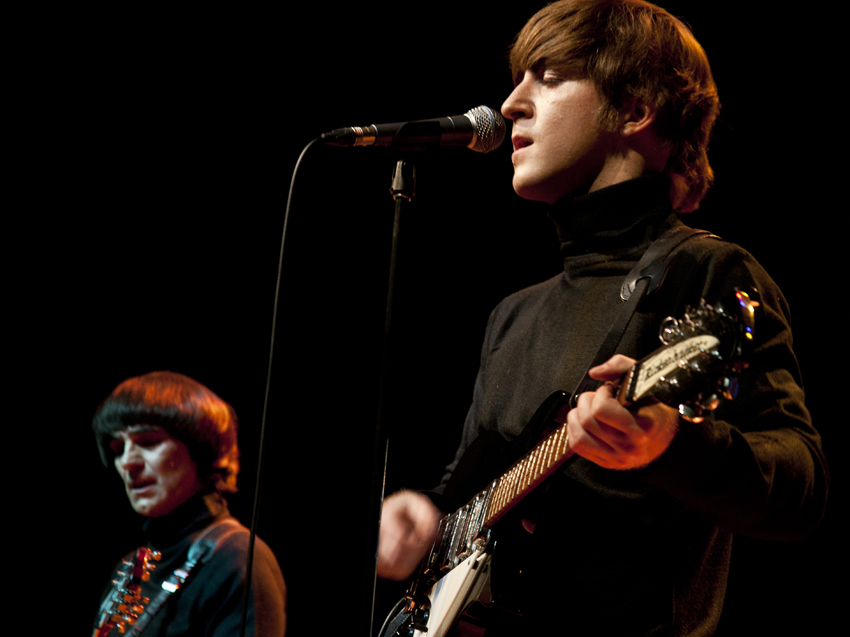
Replicating the records
As you said, you’ve been doing this a long time now. Are there any moments in the set that are still challenging to you?
You know, it’s like anything, you don’t know when something’s going to become challenging. You’re a musician playing and suddenly something that was easy two years ago might shift a bit.
The biggest thing is concentration. That’s always the challenge. You just cannot float off in that concert. Because if you’re not paying attention, if you’re doing something like I Should Have Know Better, which is a simpler solo of George’s, you can miss it because you’re not paying attention.
I would say you’ve just got to stay on form with it and keep going over the licks. We all go back to the records all the time, because any band will drift in tempo or feel, because musicians do. We bear in mind that The Beatles are actually seven or eight Beatles, because they changed so much. There are so many different styles that you have to encompass. You’ve got that early one, then the beat group, then country, psychedelic and so on. It’s a lot of styles to take in and keep on top of.
It’s some feat of stamina, and of course it’s something that they never had to do.
They didn’t. And if you listen to those BBC recordings, generally George won’t play the same solo twice on a rock and roll song. He’s free to ad lib. In a way the restriction is a drag, but in a way it’s fantastic as you’re trying to recreate a great moment from a band that you love. People aren’t coming to see me ad lib around as George Harrison, they want to hear the record and see how close we can get.
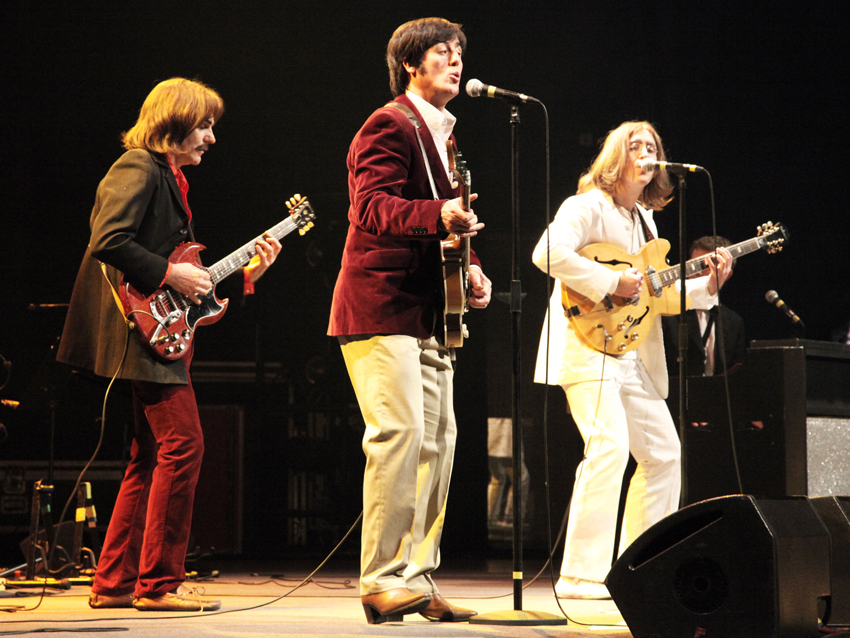
Picking the songs
How do you formulate the set?
We try and do a run of the same set and then we’ll change it drastically. At the moment, we’re doing lots of A Hard Day’s Night, doings songs like I Should Have Known Better and Happy Just To Dance With You, stuff we haven’t done for a while, and then a whole other bunch of songs from the early career, going into Shea Stadium et cetera.
We’ll change that set completely when we go out on the next tour. And we work on all kinds of different songs in sound check, constantly. We don’t just have 29 songs. We’re very lucky because the ranges of everybody in the group can reach the range of The Beatles, so if we want to do Rock And Roll Music or Long Tall Sally we can. We’re always going through stuff like It Won’t Be Long or And Your Bird Can Sing, which is a tough one. On the record I think that’s George and Paul playing in harmony, but really in order to keep the rhythm guitar going properly in a four piece I’ve had to learn the whole thing in double stops, and that is a real tough one because it’s quite fast as well.
You must have fun digging out b-sides and lesser-known album tracks?
We do, b-sides particularly we love doing. In sound checks we’re been doing I’ll Get you, which is the b-side to She Loves You, and that is just a joyous song to play. Occasionally we’ll chuck it in to the performance out of the blue. We work on stuff all the time. We did Happiness Is A Warm Song recently and that’s a belting song to get down. Very complex but brilliant.
It must be fun to watch those songs hit home on an audience live too.
It’s funny you mention that, because something like Happiness Is A Warm Gun, some people wouldn’t consider that too much. But when they see the songs done live, they go off to check out the LPs. That’s a great moment, you feel like you’re selling The Beatles to fans who maybe haven’t delved as deep.
The Bootleg Beatles are currently on tour – for dates and more information, visit the official Bootleg Beatles website.